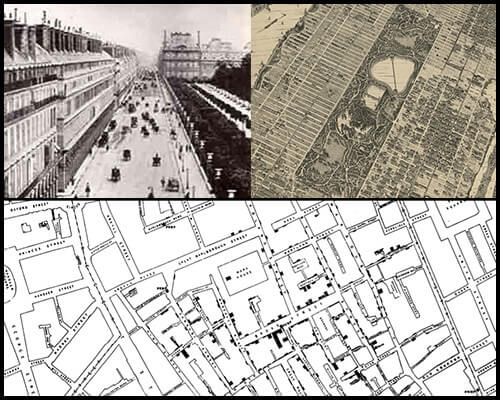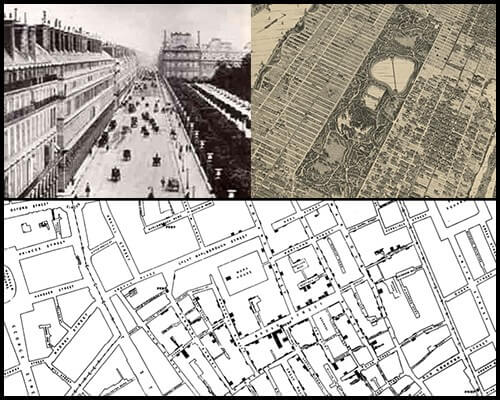-
Lessons from diseases of the past
Over the centuries, epidemics have impacted the way people interact with each other as well as the built environment. The 1854 map of London by John Snow helped identify sources of cholera and led to changes in how the water and waste systems of London were designed. The Haussmann plan for Paris, Olmsted’s Central Park in New York City, and the Shanghai Customs Harbour Quarantine Station were all 19th Century responses to infectious diseases. Even further back, British historian Mark Bailey explains that the sharp reduction in the labour force after the Black Death in the 1350s boosted survivors’ wage bargaining power and disposable incomes. These income gains were then spent on better quality ale and food in public houses[1], giving rise to the pub culture. Given pubs’ ubiquitous role in British life, this change has been consequential both culturally and from a real estate perspective. Even as hundreds of public houses across the UK begin to reopen in the summer of 2020, all are operating under severe capacity restrictions. With modern airline travel and intercontinental mobility, the world has graduated from epidemics to pandemics. The sobering result: the bars and pubs along Clarke Quay in Singapore, Lan Kwai Fong in Hong Kong, and Rush Street in Chicago are in a similar state of partial or complete closure.
Over the centuries, epidemics have impacted the way people interact with each other as well as the built environment.

Clockwise from upper left: Rue de Rivoli, Paris; Central Park, New York; John Snow’s map of London From where we stand today, thinking about a post-COVID world may seem premature. Both the resurgence of infection rates in the US (pg. 6), as well as localised second-order shutdowns in places as far from each other as Barcelona, Dallas, or Melbourne exemplify the fluidity of the phases of the pandemic. Nonetheless, we do believe a “COVID under Control” phase will eventually arrive, as cautiously optimistic news on treatments and a potential vaccine revealed during July (pg. 22).
Once an effective vaccine is available, sorting out permanent versus temporary changes in culture or behaviour will take time. Interested readers should refer to Chapter 3 of the 2020 ISA Mid-Year Update as it delves into what the future of real estate sectors might look like post-pandemic, as well as the connections to other global threats such as climate change.
The second quarter data for the real economy paints a disturbing picture in most countries. Despite massive government support in parts of the world, the destruction of jobs brought on by this pandemic has undone a decade’s worth of unemployment decline in the OECD countries (pg. 3). Traditional sources of data take time to assemble, and by the time they are published they tend to reflect information that is already several months old. So, turning to high-frequency activity data helps paint a timely picture of economic activity. For instance, travel to workplaces and retail locations continue to rise; restaurant reservations (pg. 9) and airplane travel also seem to be trending modestly upwards in July (pg. 8), even as Q2 GDP are reported showing historic declines.
Real estate valuation data is also impacted from lags and timing issues. For instance, the latest available valuation-based indices reflect data only up to the end of Q1 in many countries. Few properties have been changing hands (pg. 25), providing less comparable transactions. Thus, it will take some time for new information to be incorporated into the wider index. Real estate trusts and companies traded on listed exchanges uncover important insights for private equity and real estate debt. Through real-time trading and pricing, these securities swiftly reflect changes in the underlying health of occupier markets and risk premia required to hold real estate assets. Global REIT valuations swung from trading at a healthy premium to private market valuations pre-pandemic to now trading at a discount (pg. 26). While this discount has narrowed over recent months, the pricing gap is wider than in recent decades. Given the importance of transactional evidence to private market valuations in times of high uncertainty, we believe this dislocation between public/private markets is likely to persist for some time. The disconnect opens a window for investors to exploit this discrepancy between public and private market pricing.
Public markets can give us a steer as to how investors are assessing the relative risks and opportunities across sectors. The sector hierarchy in REIT pricing broadly coincides with the uncertainty around each sector’s prospects alluded to in Chapter 3 of the Mid-year ISA. Retail and office REITs are trading at wider discount than they have typically done, and industrials and residential REITs are trading at a healthy premium (pg. 27).
We would love to exchange views with you on the future post-COVID world. You can send us an email to this address:Research@lasalle.com
[1] “How the Black Death Gave Rise to British Pub Culture” https://go.lasalle.com/e/579181/rticles-what-is-the-oldest-pub/

May 01, 2025
PERE: Europe Debt roundtable 2025
Dave White sat down with peers from other leading alternative credit providers across Europe to discuss the state of real estate debt across the continent



